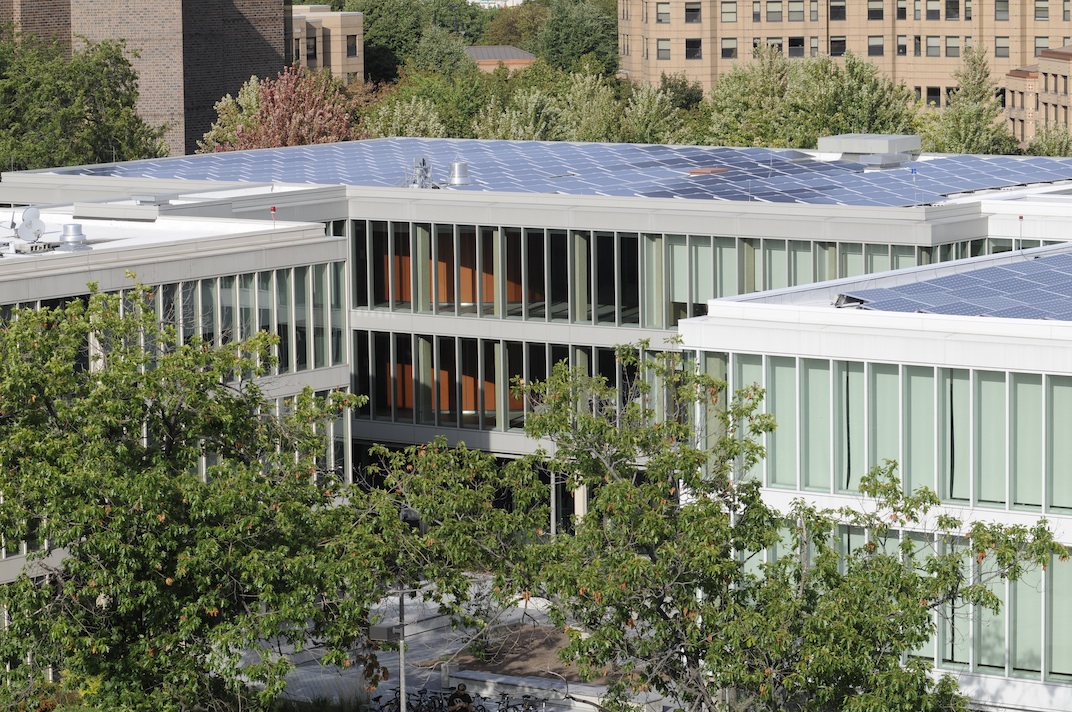Code Green Solutions


In 2009, the University of Illinois at Chicago’s (UIC) Douglas Hall underwent a massive renovation and became incredibly energy efficient. So much so that the U.S. Green Building Council (USGBC) awarded UIC with a LEED-Gold rating. LEED (Leadership in Energy and Environmental Design) is the national recognition verification system that a building is environmentally friendly and a healthy place to work and live. Not only does the building use less energy than conventional buildings, it actually produces energy!
As part of the reconstruction, 245 solar photovoltaic (PV) panels were installed on the roof of the home of UIC’s College of Business. These PV panels convert solar radiation into direct current (DC) electricity. UIC tracks the amount of electricity produced, and anyone can see the energy created at any given day. For example, this year’s Independence Day created 347 kWh of electricity. How much energy did the PV panels create on your birthday? Find out here.
Since its installation in September 2011, the solar panels have produced a whopping 195 MWh. That’s practically 67 MWh annually, or roughly 8% of the buildings energy needs. That’s 67,000 kWh renewable energy produced plus 67,000 kWh of energy not produced from polluting coal-fired power plants.
UIC is reducing the need to use energy from carbon-producing energy sources and therefore reducing its greenhouse gas emissions. In the 2009 UIC Climate Action Plan, UIC commits to reducing greenhouse gas emissions from 2004 levels by 40% by 2030 and by at least 80% by 2050, without accounting for offsets. The plan outlines various strategies to accomplish this by creating energy efficiency projects, improving transportation options, improving ground operations, recycling, and using clean and renewable resources.
The PV panel project on top Douglas Hall has contributed to reducing greenhouse gases by 43 metric tons of carbon dioxide! Although that may not seem like a huge number, remember that is just one small classroom building- just imagine if all of UIC buildings acted like Douglas Hall.
Not only to the solar panels reduce carbon emissions, so do the other innovative energy efficient systems built for Douglas hall. Located underground just to north-west of Douglas Hall, one will stand on top of the 64 geothermal wells dug 500 feet deep into the ground. That’s deeper than the 28-story University Hall next to the well field. The building uses ground source heat pumps to tap into the geothermal energy to both heat and cool it. Douglas hall uses a closed-loop system with sensors, heat pumps and air exchangers, taking advantage of the relatively constant 50-degree F earth temperatures in the well field to maintain a comfortable indoor air environment year-round.
The other ingenious energy efficient aspects of Douglas Hall that helped it earn LEED Gold are automated shades to manage heat load and cooling sensors on the roof to detect the heat load inside the building. The system automatically adjusts lights, cooling/heating levels, and heights of window blinds in order to regulate the building temperature.
Through the Chevy Clean Energy Campus program, UIC has sold these carbon reductions to Chevy, who has committed to retiring these credits. Revenue from those sales will be used to support UIC’s Sustainability Internship Program and create more energy savings for the campus.
The photovoltaic system on the roof of Douglas Hall was partially funded by a grant from the Illinois Clean Energy Community Foundation.